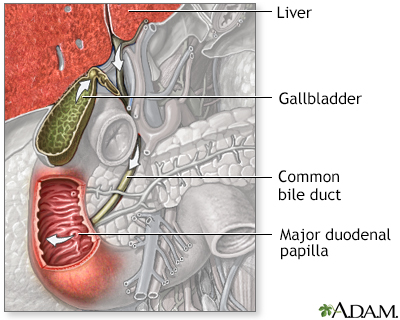Pregnancy SmartSiteTM
Bile duct stricture; Biliary stricture DefinitionA bile duct stricture is an abnormal narrowing, most often of the common bile duct. This is a tube that moves bile from the liver to the small intestine. Bile is a substance that helps with digestion. CausesA bile duct stricture is often caused by injury to the bile ducts during surgery. For example, it may occur after surgery to remove the gallbladder. Other causes of this condition include:
SymptomsSymptoms include:
Exams and TestsThe following tests can help diagnose this condition:
The following blood tests can help reveal a problem with the biliary system.
This condition may also alter the results of the following tests:
TreatmentThe goal of treatment is to correct the narrowing. This will allow bile to flow from the liver into the intestine. This may involve:
If surgery is done, the stricture is removed. The common bile duct will be rejoined with the small intestine. In some cases, a tiny metal or plastic mesh tube (stent) is placed across the bile duct stricture to keep it open. Outlook (Prognosis)Treatment is successful most of the time. Long-term success depends on the cause of the stricture. Possible ComplicationsInflammation and narrowing of the biliary duct may return in some people. There is a risk for infection above the narrowed area. Strictures that remain for a long period can lead to liver damage (cirrhosis). When to Contact a Medical ProfessionalContact your health care provider if symptoms recur after pancreatitis, cholecystectomy, or other biliary surgery. ReferencesDudeja V, Ferrantella A, Fong Y. The liver. In: Townsend CM Jr, Beauchamp RD, Evers BM, Mattox KL, eds. Sabiston Textbook of Surgery. 21st ed. St Louis, MO: Elsevier; 2022:chap 54. Fogel EL, Sherman S. Diseases of the gallbladder and bile ducts. In: Goldman L, Cooney KA, eds. Goldman-Cecil Medicine. 27th ed. Philadelphia, PA: Elsevier; 2024:chap 141. Lillemoe HA, Lillemoe KD. Gallbladder and biliary tree: management of benign biliary strictures. In: Cameron J, ed. Current Surgical Therapy. 14th ed. Philadelphia, PA: Elsevier; 2023:457-538. | |
| |
Review Date: 5/14/2024 Reviewed By: Jenifer K. Lehrer, MD, Department of Gastroenterology, Aria - Jefferson Health Torresdale, Jefferson Digestive Diseases Network, Philadelphia, PA. Review provided by VeriMed Healthcare Network. Also reviewed by David C. Dugdale, MD, Medical Director, Brenda Conaway, Editorial Director, and the A.D.A.M. Editorial team. The information provided herein should not be used during any medical emergency or for the diagnosis or treatment of any medical condition. A licensed medical professional should be consulted for diagnosis and treatment of any and all medical conditions. Links to other sites are provided for information only -- they do not constitute endorsements of those other sites. No warranty of any kind, either expressed or implied, is made as to the accuracy, reliability, timeliness, or correctness of any translations made by a third-party service of the information provided herein into any other language. © 1997- A.D.A.M., a business unit of Ebix, Inc. Any duplication or distribution of the information contained herein is strictly prohibited. | |

 Bile pathway
Bile pathway
